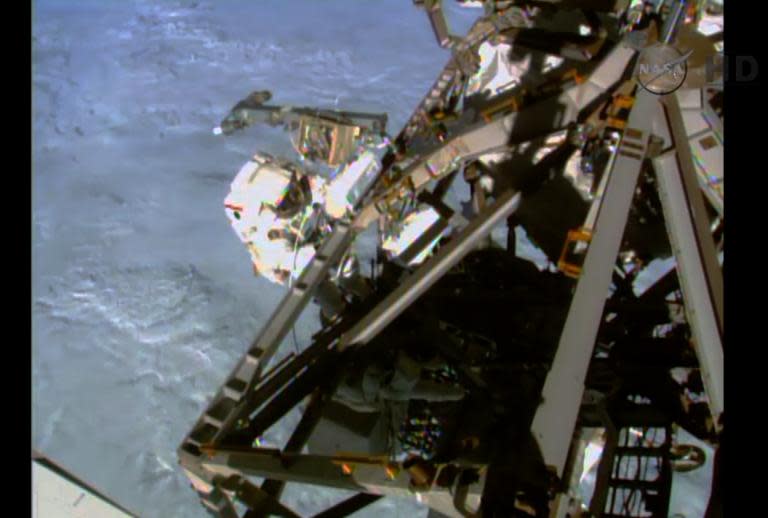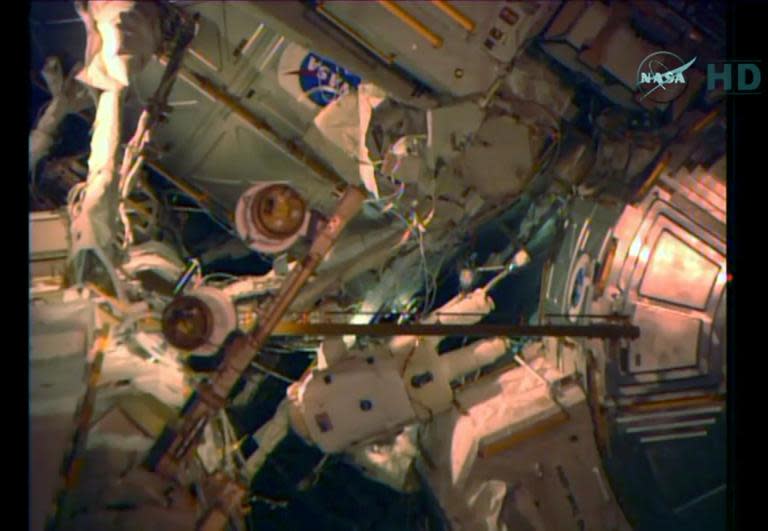US astronauts speed through spacewalk at orbiting lab
Two US astronauts on Sunday made speedy work of their third spacewalk to get the International Space Station ready for the arrival of more commercial spacecraft in the coming years. Tethered to the outside of the orbiting outpost, space station commander Barry Wilmore and flight engineer Terry Virts reported no problems with their spacesuits during the outing, but Virts discovered a small amount of water building up in his helmet after he re-entered the space station. A similar problem occurred after Wednesday's spacewalk, when about three inches of water collected in Virts' headpiece, but NASA said the problem did not put the astronauts in danger. Still, the US space agency has expressed concern about repeated technical failures in the American spacesuits, all linked to the same cooling system and a 2013 emergency water leak that nearly drowned Italian spacewalker, Luca Parmitano. This time, Virts described the water as appearing like condensation, and he said there was about the same amount he had seen on the prior spacewalk, when about 15 milliliters was collected. "Virts's suit, suit number 3005, has a history of what is called sublimator water carryover," said a NASA commentator on the space agency's live broadcast. "Essentially a small amount of residual water forms in the sublimator cooling component, that condenses once the suit is re-introduced to a repressurized enviroment after being exposed to vacuum... resulting in a small amount of water pushing into the helmet." He added it was "not an issue" for the astronauts' safety. - Fast workers - Embarking on their third spacewalk in eight days, the duo completed their tasks in five hours and 38 minutes, about an hour earlier than planned. "You guys have done an outstanding job, even for two shuttle pilots," said Suni Williams, herself a veteran shuttle astronaut and spacewalker who, working from mission control in Houston, led the men through their tasks in orbit. The astronauts each installed a boom with two antennas for a communications system so that future crews launching from Florida on US commercial spacecraft will be able to park at the space station, NASA said. Then they routed 400 feet (122 meters) of cable, securing it with copper wire ties as they manuevered across handrails on the space station. During the previous two spacewalks, Wilmore and Virts installed more cable and lubricated the latching portions of the space station robotic arm, which NASA said had grown "arthritic" after more than a decade in space. Sunday's spacewalk was the 187th in the history of the space station, and one of many planned for the coming year to prepare the space station for a new era in human spaceflight, when more commercial vehicles will be arriving at the research outpost carrying astronauts. Boeing and SpaceX are working on new spaceships that will carry astronauts to space, restoring US access to low-Earth orbit following the retirement of the US space shuttle program in 2011. Boeing's crew vehicle, called CST-100, is planning its first flight with a pilot and astronaut in late 2017, and SpaceX hopes to follow soon after with its Dragon V2. Until then, the world's astronauts must pay $70 million per seat for transport aboard Russia's Soyuz capsules.

 Yahoo Finance
Yahoo Finance 

